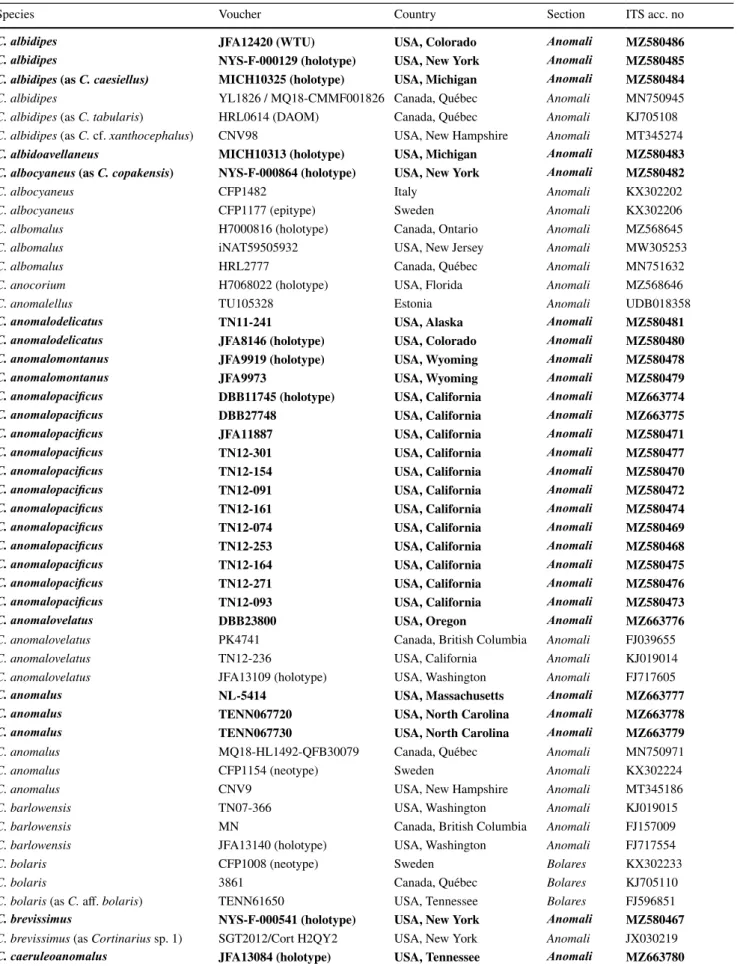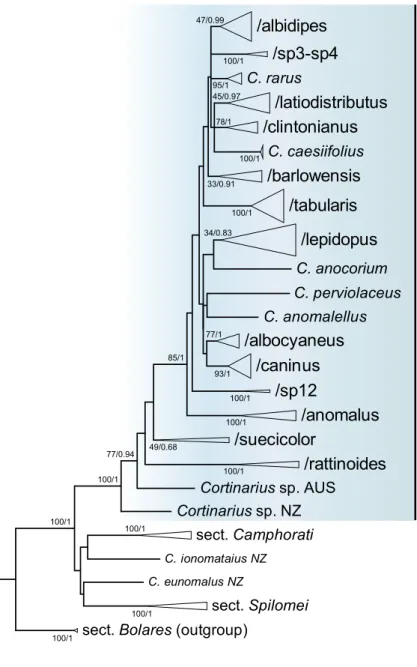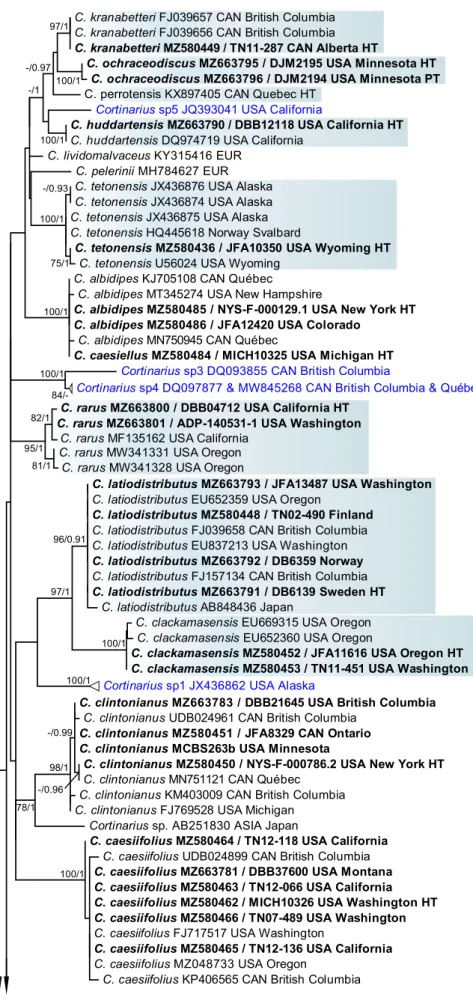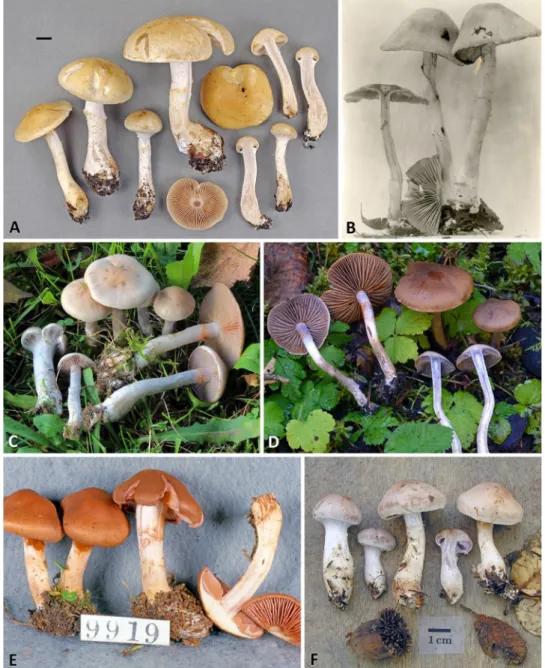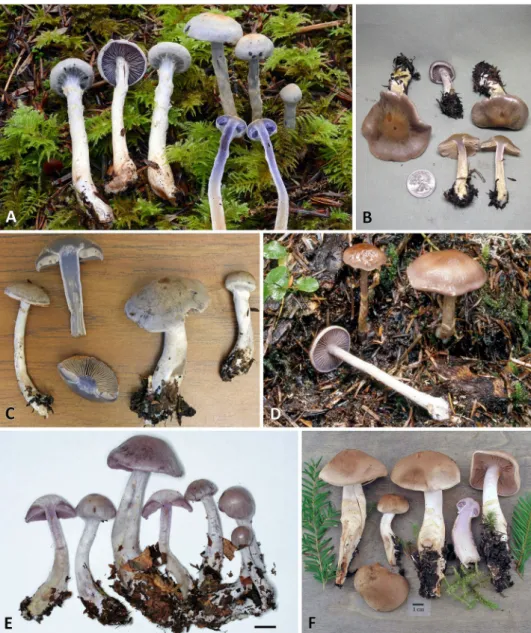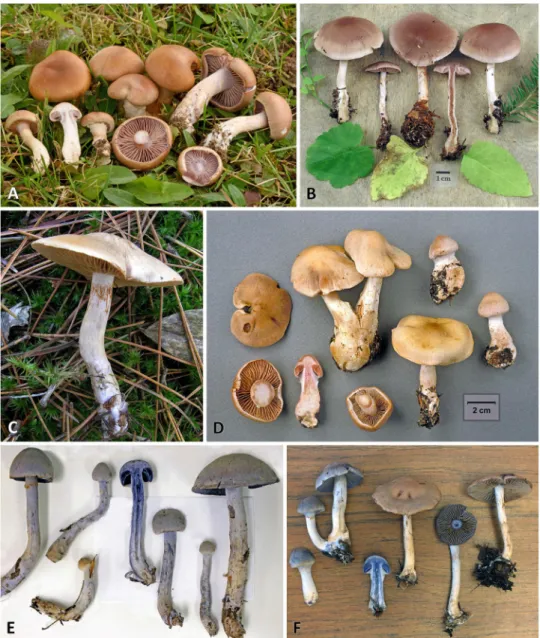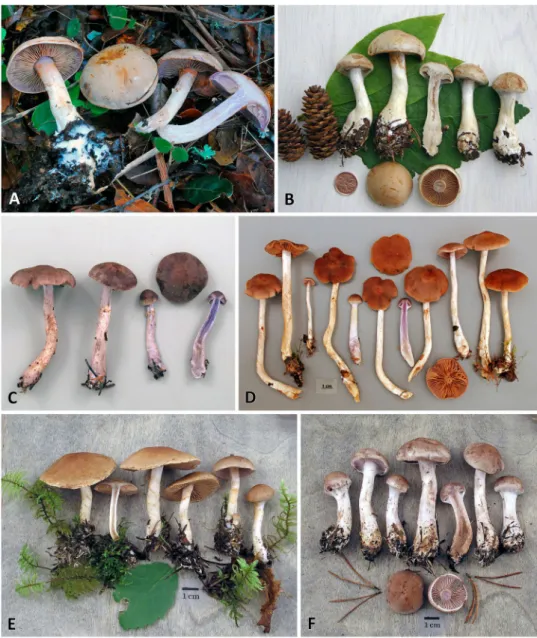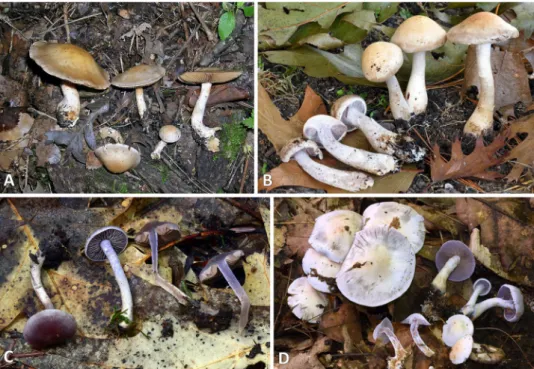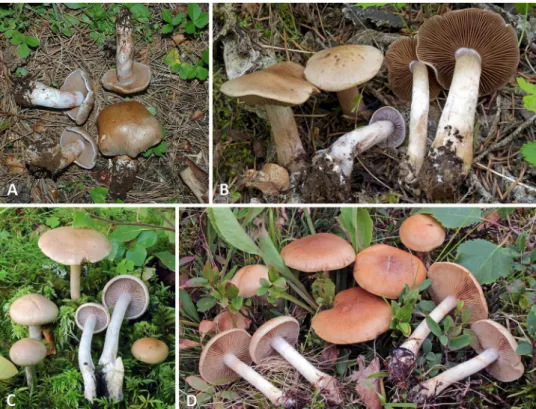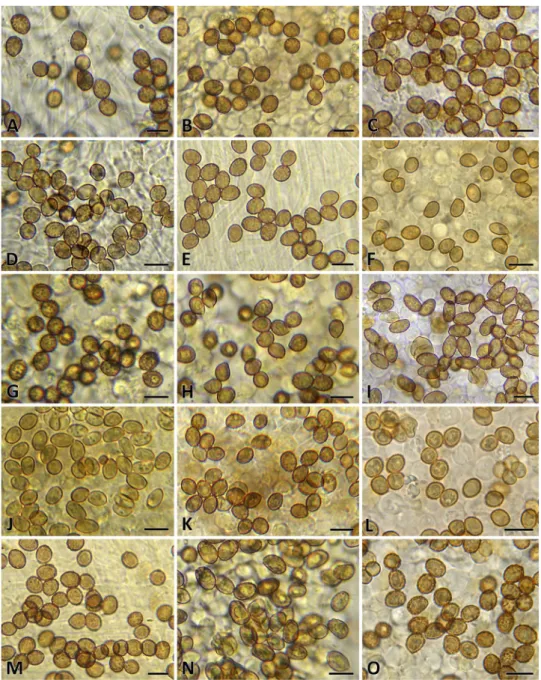https://doi.org/10.1007/s11557-021-01738-0 ORIGINAL ARTICLE
Type studies and fourteen new North American species of Cortinarius section Anomali reveal high continental species diversity
Bálint Dima1 · Kare Liimatainen2 · Tuula Niskanen2 · Dimitar Bojantchev3 · Emma Harrower4 · Viktor Papp5 · László G. Nagy1,6 · Gábor M. Kovács1 · Joseph F. Ammirati7
Received: 14 June 2021 / Revised: 19 August 2021 / Accepted: 20 August 2021
© The Author(s) 2021
Abstract
Section Anomali is a species-rich group in North America belonging to Cortinarius, the most diverse genus in the Agaricales.
This study is based on extensive morphological investigations and molecular methods using 191 nrDNA ITS sequence data and recovered 43 phylogenetic species from which 14 are described here as new to science. We sequenced ten type materials which belonged to eight species. The synonymy of C. caesiellus with C. albidipes and C. copakensis with C. albocyaneus is proposed here. The North American occurrence of four species (C. albocyaneus, C. anomalus, C. caninus, and C. tabularis), so far known only from Europe, was confirmed. Thirteen species were not formally described here due to lack of relevant information. An identification key to the known Anomali species in North America is provided.
Keywords DNA barcoding · Ecology · ITS phylogeny · Morphology · Taxonomy · Type specimens
Introduction
Cortinarius is an important ectomycorrhizal genus in the Agaricales and is known to be the largest agaric genus worldwide (e.g., Garnica et al. 2016; Liimatainen et al.
2017, 2020; Varga et al. 2019). Species recognition based
on morphology is difficult in Cortinarius lineages due to overlapping species characteristics and variation within spe- cies (e.g., Frøslev et al. 2007; Niskanen et al. 2009, 2013, 2016; Liimatainen et al. 2014, 2015).
Section Anomali represents a monophyletic, globally distributed group of Cortinarius (e.g., Soop et al. 2019) characterized by a telamonioid/sericeocyboid appearance, often with yellowish to brownish universal veil remnants on the stipe, typically bluish young lamellae, and subglo- boid to broadly ellipsoid or rarely ellipsoid, verrucose spores. In section Anomali, more than 50 binomials were introduced in the last century, mainly from Europe with fewer from North America and elsewhere, but only ca.
20% of these names have been in general use (Dima et al.
2017). Classical European species were examined and typified in Dima et al. (2016) prior to studying species from other parts of the world, such as North America, where knowledge of sect. Anomali has been limited. Some earlier workers (e.g., Peck 1873, 1874, 1878, 1888, 1912;
Murrill 1946; Kauffman 1905, 1932; Kauffman and Smith 1933; Smith 1939, 1944), and a few recent ones (Ammirati 2014; Ammirati et al. 2017; Liimatainen and Niskanen 2021) described a dozen species from the North and Cen- tral America. However, to date, the classical European names such as C. anomalus, C. albocyaneus, C. tabularis, and others have been applied to most of the taxa in North
Section editor: Zhu-Liang Yang
* Bálint Dima
cortinarius1@gmail.com
1 Department of Plant Anatomy, Institute of Biology, Eötvös Loránd University, Pázmány Péter sétány 1/c, 1117 Budapest, Hungary
2 Jodrell Laboratory, Royal Botanic Gardens, Kew TW9 3AB, Surrey, UK
3 Hercules, USA
4 Vancouver, Canada
5 Department of Botany, Hungarian University of Agriculture and Life Sciences, Ménesi út 44, 1118 Budapest, Hungary
6 Synthetic and Systems Biology Unit, Institute
of Biochemistry, Biological Research Centre, Hungarian Academy of Sciences, Temesvári krt. 62, 6726 Szeged, Hungary
7 Department of Biology, University of Washington, P. Box 351800, Seattle, WA 98195-1800, USA
America (Harrower et al. 2011). This is a general prob- lem based on recent phylogenetic revisions in Cortinarius (e.g., Liimatainen et al. 2014, 2020; Garnica et al. 2016;
Soop et al. 2019) and similar to what has occurred in other groups of fungi (e.g., Kropp et al. 2010).
To extend the knowledge of the taxonomy and distri- bution of species in section Anomali in North America, we present here an extensive nuc rDNA ITS1–5.8S–ITS2 (ITS barcode) dataset as a phylogenetic and taxonomic framework, based on sequences from basidiomata, includ- ing type materials and environmental samples belonging to this group of Cortinarius. Our taxonomic revision is based on both phylogenetic data and detailed macro- and microscopical observations.
Materials and methods
Taxon samplingOwn material and published data were analyzed. The following type materials described from North America were investigated from the FLAS-F, MICH, and NYS her- baria: C. albidipes, C. albidoavellaneus, C. brevissimus, C. caesiellus, C. caesiifolius, C. copakensis, C. clintoni- anus, C. deceptivus, C. modestus, and C. perviolaceus.
BLASTn comparisons (Altschul et al. 1997) against Gen- Bank (http:// www. ncbi. nlm. nih. gov/) and UNITE (http://
unite. ut. ee/) databases were used to download sequences of sect. Anomali and related lineages focusing on North America as well as sequences from Europe, Asia, Central and South America, and Australasia (Table 1).
Molecular analysis
The universal fungal DNA barcode region (Schoch et al. 2012), the ribosomal internal transcribed spacer (ITS1–5.8S–ITS2) was amplified, sequenced and analyzed.
A total of 81 ITS sequences belonging in sect. Anomali were generated in this study, of which 77 originated from specimens collected in North America (Table 1). For DNA extraction, PCR, and sequencing, we followed the proto- cols described in Liimatainen et al. (2014) and Dima et al.
(2016). Primer pairs of ITS1F-ITS4 or ITS1F-ITS4B, and alternatively in case of old type materials ITS1F/ITS2 and ITS3/4 (Gardes and Bruns 1993; White et al. 1990), were used to amplify the whole or partial ITS region. Sequenc- ing was performed at the University of Helsinki (Finland) or at LGC Genomics (Berlin, Germany). GenBank acces- sion numbers of the novel sequences are listed in Table 1.
Phylogenetic analyses
Sequences were aligned in MAFFT v7 (http:// mafft. cbrc.
jp/ align ment/ server) choosing the E-INS-I method (Katoh and Standley 2013) under default settings. SeaView 4 (Gouy et al. 2010) was used to inspect the alignment.
Based on the work of Nagy et al. (2012), phylogeneti- cally informative indels were coded as presence/absence data with FastGap 1.2 (Borchsenius 2009) following the simple indel coding algorithm (Simmons et al. 2001). The final alignment including nucleotide and binary data was analyzed in RAxML (Stamatakis 2014) and MrBayes 3.1.2 (Ronquist and Huelsenbeck 2003). Maximum Likelihood (ML) phylogenetic reconstruction was performed in raxm- lGUI (Silvestro and Michalak 2012) using rapid bootstrap analysis with 2000 replicates. Three nucleotide partitions (ITS1, 5.8S, ITS2) were set to the GTRGAMMA substitu- tion model in addition to one binary partition (indel char- acters) that was set to default. In the Bayesian Inference (BI) phylogeny, the alignment was divided into four parti- tions (ITS1, 5.8S, ITS2, and indels) as well. The GTR + Γ substitution model was applied to the nucleotide charac- ters, while the two-parameter Markov model was set for the indels. Two independent runs of four Markov Chain Monte Carlo (MCMC) were performed each for 5,000,000 generations, sampling every 1000th generation. The first 30% of the trees was discarded as burn-in. For the remain- ing trees, a 50% majority rule consensus phylogram with posterior probabilities as nodal supports was computed.
Intra- and interspecific genetic differences were calculated by dividing the number of differences (substitutions and/or indels) found in the whole ITS region by the length of the region (ca. 610–618 bases long). The best scoring ML tree from Maximum Likelihood analysis was further edited in MEGA 7 (Kumar et al. 2016) and Adobe Illustrator CS4 and shown in Figs. 1 and 2.
Morphological study
The morphological descriptions of the species are based on notes taken from fresh collections and associ- ated photographs, fungarium specimens, and previously published descriptions of the holotype specimens and other sequenced materials or collections that are not sequenced. Microscopic characteristics are taken from air-dried specimens. Dextrinoid basidiospore reactions were recorded from pieces of lamellae placed in Melzer’s reagent for 5 min. Lamella trama hyphae were examined for encrusting pigment in Melzer’s reagent and 3% KOH.
The pileipellis and basidia were examined in 3% KOH.
Basidiospore measurements were made in 3% KOH from
Table 1 The nrDNA ITS sequences of Cortinarius species used in the phylogenetic analysis. Newly generated sequences are in boldface.
Species Voucher Country Section ITS acc. no
C. albidipes JFA12420 (WTU) USA, Colorado Anomali MZ580486
C. albidipes NYS-F-000129 (holotype) USA, New York Anomali MZ580485
C. albidipes (as C. caesiellus) MICH10325 (holotype) USA, Michigan Anomali MZ580484
C. albidipes YL1826 / MQ18-CMMF001826 Canada, Québec Anomali MN750945
C. albidipes (as C. tabularis) HRL0614 (DAOM) Canada, Québec Anomali KJ705108
C. albidipes (as C. cf. xanthocephalus) CNV98 USA, New Hampshire Anomali MT345274
C. albidoavellaneus MICH10313 (holotype) USA, Michigan Anomali MZ580483
C. albocyaneus (as C. copakensis) NYS-F-000864 (holotype) USA, New York Anomali MZ580482
C. albocyaneus CFP1482 Italy Anomali KX302202
C. albocyaneus CFP1177 (epitype) Sweden Anomali KX302206
C. albomalus H7000816 (holotype) Canada, Ontario Anomali MZ568645
C. albomalus iNAT59505932 USA, New Jersey Anomali MW305253
C. albomalus HRL2777 Canada, Québec Anomali MN751632
C. anocorium H7068022 (holotype) USA, Florida Anomali MZ568646
C. anomalellus TU105328 Estonia Anomali UDB018358
C. anomalodelicatus TN11-241 USA, Alaska Anomali MZ580481
C. anomalodelicatus JFA8146 (holotype) USA, Colorado Anomali MZ580480
C. anomalomontanus JFA9919 (holotype) USA, Wyoming Anomali MZ580478
C. anomalomontanus JFA9973 USA, Wyoming Anomali MZ580479
C. anomalopacificus DBB11745 (holotype) USA, California Anomali MZ663774
C. anomalopacificus DBB27748 USA, California Anomali MZ663775
C. anomalopacificus JFA11887 USA, California Anomali MZ580471
C. anomalopacificus TN12-301 USA, California Anomali MZ580477
C. anomalopacificus TN12-154 USA, California Anomali MZ580470
C. anomalopacificus TN12-091 USA, California Anomali MZ580472
C. anomalopacificus TN12-161 USA, California Anomali MZ580474
C. anomalopacificus TN12-074 USA, California Anomali MZ580469
C. anomalopacificus TN12-253 USA, California Anomali MZ580468
C. anomalopacificus TN12-164 USA, California Anomali MZ580475
C. anomalopacificus TN12-271 USA, California Anomali MZ580476
C. anomalopacificus TN12-093 USA, California Anomali MZ580473
C. anomalovelatus DBB23800 USA, Oregon Anomali MZ663776
C. anomalovelatus PK4741 Canada, British Columbia Anomali FJ039655
C. anomalovelatus TN12-236 USA, California Anomali KJ019014
C. anomalovelatus JFA13109 (holotype) USA, Washington Anomali FJ717605
C. anomalus NL-5414 USA, Massachusetts Anomali MZ663777
C. anomalus TENN067720 USA, North Carolina Anomali MZ663778
C. anomalus TENN067730 USA, North Carolina Anomali MZ663779
C. anomalus MQ18-HL1492-QFB30079 Canada, Québec Anomali MN750971
C. anomalus CFP1154 (neotype) Sweden Anomali KX302224
C. anomalus CNV9 USA, New Hampshire Anomali MT345186
C. barlowensis TN07-366 USA, Washington Anomali KJ019015
C. barlowensis MN Canada, British Columbia Anomali FJ157009
C. barlowensis JFA13140 (holotype) USA, Washington Anomali FJ717554
C. bolaris CFP1008 (neotype) Sweden Bolares KX302233
C. bolaris 3861 Canada, Québec Bolares KJ705110
C. bolaris (as C. aff. bolaris) TENN61650 USA, Tennessee Bolares FJ596851
C. brevissimus NYS-F-000541 (holotype) USA, New York Anomali MZ580467
C. brevissimus (as Cortinarius sp. 1) SGT2012/Cort H2QY2 USA, New York Anomali JX030219
C. caeruleoanomalus JFA13084 (holotype) USA, Tennessee Anomali MZ663780
Table 1 (continued)
Species Voucher Country Section ITS acc. no
C. caeruleoanomalus PBM3902/TENN068383 USA, North Carolina Anomali KY744156
C. caesiifolius TN12-136 USA, California Anomali MZ580465
C. caesiifolius TN12-066 USA, California Anomali MZ580463
C. caesiifolius TN12-118 USA, California Anomali MZ580464
C. caesiifolius TN07-489 USA, Washington Anomali MZ580466
C. caesiifolius DBB37600 USA, Minnesota Anomali MZ663781
C. caesiifolius MICH10326 (holotype) USA, Washington Anomali MZ580462
C. caesiifolius SAT13-298–15 USA, Oregon Anomali MZ048733
C. caesiifolius JMB10-20–2007-15 USA, Washington Anomali FJ717517
C. caesiifolius (as C. cf. ochrophyllus) UBC-F28442 Canada, British Columbia Anomali KP406565 C. caesiifolius (as Cortinarius sp.) UBC-F31305 Canada, British Columbia Anomali UDB024899
C. camphoratus EH23 Canada, British Columbia Camphorati FJ717505
C. caninus JFA7985 Canada, Ontario Anomali MZ580454
C. caninus NS18 USA, California Anomali MZ663782
C. caninus JFA10347 USA, Wyoming Anomali MZ580459
C. caninus JFA9425 USA, Wyoming Anomali MZ580461
C. caninus JFA12434 USA, Wyoming Anomali MZ580456
C. caninus JFA9470 USA, Wyoming Anomali MZ580457
C. caninus JFA10348 USA, Wyoming Anomali MZ580460
C. caninus JFA8009 USA, Minnesota Anomali MZ580455
C. caninus JFA9920 USA, Wyoming Anomali MZ580458
C. caninus (as Unc. EcM) TH4Cc Canada, British Columbia Anomali KF753582
C. caninus CFP627 (epitype) Sweden Anomali KX302250
C. clackamasensis JFA11616 (holotype) USA, Oregon Anomali MZ580452
C. clackamasensis TN11-451 USA, Washington Anomali MZ580453
C. clackamasensis (as C. barlowensis) OSC109672 USA, Oregon Anomali EU652360
C. clackamasensis (as C. barlowensis) OSC114858 USA, Oregon Anomali EU669315
C. clintonianus DBB21645 Canada, British Columbia Anomali MZ663783
C. clintonianus JFA8329 Canada, Ontario Anomali MZ580451
C. clintonianus MIN896348 USA, Minnesota Anomali MZ663784
C. clintonianus NYS-F-000786 (holotype) USA, New York Anomali MZ580450
C. clintonianus YL2618 / MQ18-CMMF002618 Canada, Québec Anomali MN751121
C. clintonianus (as Cortinarius sp.) UBC-F31352 Canada, British Columbia Anomali UDB024961
C. clintonianus (as Unc. clone) 136C Canada, British Columbia Anomali KM403009
C. clintonianus (as Unc. clone) SDL13 USA, Michigan Anomali FJ769528
C. deceptivus NL-5180 USA, New York Anomali MZ663785
C. deceptivus WTU-F-69333 USA, New Hampshire Anomali MZ663786
C. deceptivus WTU-F-69313 USA, Massachusetts Anomali MZ663787
C. deceptivus MICH10343 (syntype) USA, New York Anomali MZ663788
C. deceptivus iNAT56430786 USA, New York Anomali MT939445
C. durifoliorum PDD101829 (holotype) New Zealand Anomali KJ635210
C. dysodes PDD70499 (holotype) New Zealand Camphorati GU233340
C. epsomiensis K(M)74,963 (holotype) UK Anomali MK010952
C. epsomiensis (as C. pastoralis, holo-
type) TN06-165 Finland Anomali KX302258
C. eunomalus PDD94040 (holotype) New Zealand incertae sedis JQ287690
C. ferrusinus JB8106 13 (holotype) Spain Spilomei KY657254
C. harvardensis NL-5415 (holotype) USA, Massachusetts Anomali MZ663789
C. harvardensis MQ18-HL1449-QFB30070 Canada, Québec Anomali MN751560
C. harvardensis MQ17058-QFB29566 Canada, Québec Anomali MN751559
Table 1 (continued)
Species Voucher Country Section ITS acc. no
C. harvardensis (as Cortinarius sp. 6) clone ads9.e Canada, Nova Scotia Anomali MK131480
C. huddartensis DBB12118 (holotype) USA, California Anomali MZ663790
C. huddartensis (as Cortinarius sp.) src174 USA, California Anomali DQ974719
C. ionomataius PDD89089 (holotype) New Zealand incertae sedis GU222303
C. jonimitchelliae HL03-339 (holotype) Sweden Anomali KX302253
C. kranabetteri TN11-287 (holotype) Canada, Alberta Anomali MZ580449
C. kranabetteri (as Cortinarius sp.) UBC-F16436 Canada, British Columbia Anomali FJ039657 C. kranabetteri (as Cortinarius sp.) UBC-F16435 Canada, British Columbia Anomali FJ039656
C. latiodistributus TN02-490 Finland Anomali MZ580448
C. latiodistributus DB6139 (holotype) Sweden Anomali MZ663791
C. latiodistributus DB6359 Norway Anomali MZ663792
C. latiodistributus JFA13487 USA, Washington Anomali MZ663793
C. latiodistributus (as C. barlowensis) OSC115143 USA, Washington Anomali EU652359 C. latiodistributus (as C. barlowensis) OSC114595 USA, Washington Anomali EU837213 C. latiodistributus (as C. cf. anomalus) UBC-F16437/SMIA46 Canada, British Columbia Anomali FJ039658 C. latiodistributus (as C. cf. barlowensis) UBC-F17514/SMI16 Canada, British Columbia Anomali FJ157134
C. latiodistributus (as Cortinarius sp.) YM187 Japan Anomali AB848436
C. lepidopus DB6253 Hungary Anomali MZ663794
C. lepidopus TAAM128884 Estonia Anomali UDB016290
C. lepidopus TU105192 Estonia Anomali UDB016140
C. lepidopus TU105182 Estonia Anomali UDB016132
C. lividomalvaceus JMT-15102001 (holotype) France Anomali KY315416
C. modestus TN10-035 Canada, Québec Anomali MZ580447
C. modestus NYS-F-001966 (holotype) USA, New York Anomali MZ580446
C. modestus MQ17140-QFB29648 Canada, Québec Anomali MN751561
C. modestus MQ17272-QFB29780 Canada, Québec Anomali MN751565
C. modestus MQ18-HL0629-QFB30005 Canada, Québec Anomali MN751564
C. modestus (as C. anomalus) Q-2313/QFB25737 Canada, Québec Anomali KJ705109
C. nettieae TN09-167 USA, Oregon Anomali MZ580444
C. nettieae JFA8747 USA, Oregon Anomali MZ580443
C. nettieae TN09-176 USA, Oregon Anomali MZ580445
C. nettieae JFA9613 (holotype) USA, Washington Anomali MZ580442
C. nettieae (as C. alboviolaceus) DAVFP27503 Canada, British Columbia Anomali EU821675
C. ochraceodiscus DJM2195 (holotype) USA, Minnesota Anomali MZ663795
C. ochraceodiscus DJM2194 USA, Minnesota Anomali MZ663796
C. pelerinii XC2012-21 (holotype) France Anomali MH784627
C. perrotensis (as Cortinarius sp.) TENN071126 (holotype) Canada, Québec Anomali KX897405
C. perviolaceus JFA9132 USA, Florida Anomali MZ580441
C. perviolaceus JFA9128 USA, Florida Anomali MZ580440
C. perviolaceus JFA9124 USA, Florida Anomali MZ580439
C. perviolaceus WU-Myc 44,566 USA, Georgia Anomali MZ663797
C. perviolaceus NL-5173 USA, Massachusetts Anomali MZ663798
C. perviolaceus JFA13070 USA, Tennessee Anomali MZ663799
C. perviolaceus (as Cortinarius sp.) FLAS-F61753 USA, Florida Anomali MH281882
C. perviolaceus (as Cortinarius sp.) FLAS-F61648 USA, Florida Anomali MH212024
C. perviolaceus (as Unc. clone) 3Bart56R USA, New Hampshire Anomali HQ022110
C. perviolaceus (as Cortinarius sp. 1) FN05_2 USA, New York Anomali KU878589
C. perviolaceus (as Cortinarius sp.) HBK-M11-2 USA, Tennessee Anomali MG982536
C. perviolaceus FLAS-F32992 (holotype) USA, Florida Anomali MZ580438
C. perviolaceus (as Cortinarius sp.) FLAS MES-2177 USA, Florida Anomali MT415970
Table 1 (continued)
Species Voucher Country Section ITS acc. no
C. putorius TN12-230 USA, California Camphorati KR011123
C. rarus DBB04712 (holotype) USA, California Anomali MZ663800
C. rarus ADP-140531–1 USA, Washington Anomali MZ663801
C. rarus (as C. cf. alboviolaceus) JLF3304 USA, California Anomali MF135162
C. rarus (as Cortinarius sp.) JLF8771 USA, Oregon Anomali MW341331
C. rarus (as Cortinarius sp.) JLF8707 USA, Oregon Anomali MW341328
C. rattinoides PDD88283 (holotype) New Zealand Anomali JX000375
C. sclerophyllarum HO-A20430A6 (paratype) Australia Anomali AY669637
C. sericeolazulinus JFA12053 (holotype) Costa Rica Anomali EF420146
C. spilomeus CFP1137 (neotype) Sweden Spilomei KX302267
C. spilomeus (as C. cf. spilomeus) SMI297 Canada, British Columbia Spilomei FJ039659
C. suecicolor PDD74698 (holotype) New Zealand Anomali JX000360
C. tabularis TN11-219 USA, Alaska Anomali MZ580437
C. tabularis TRTC156544 Canada, Québec Anomali BOLD: JULY102-08
C. tabularis TRTC156541 Canada, Québec Anomali BOLD: JULY100-08
C. tabularis IK98-1190 Finland Anomali KX302269
C. tabularis CFP949 (epitype) Sweden Anomali KX302275
C. tasmacamphoratus HO A20606A0 Australia, Tasmania Camphorati AY669633
C. tetonensis JFA10350 (holotype) USA, Wyoming Anomali MZ580436
C. tetonensis (as C. caninus) JFA10349 USA, Wyoming Anomali U56024
C. tetonensis (as C. cf. alpinus) 36_N343 Norway, Svalbard Anomali HQ445618
C. tetonensis (as Cortinarius sp.) ME12-B10 USA, Alaska Anomali JX436875
C. tetonensis (as Cortinarius sp.) ME12-B4 USA, Alaska Anomali JX436874
C. tetonensis (as Cortinarius sp.) ME12-D3 USA, Alaska Anomali JX436876
C. tristis s. Garnica TUB011917 Chile Anomali AY669648
Cortinarius sp1 (as Cortinarius sp.) ME12-D2 USA, Alaska Anomali JX436862
Cortinarius sp1 (as Unc. clone) HV_D8 USA, Alaska Anomali JX630733
Cortinarius sp1 (as Unc. clone) MEN-JG-096 Norway, Svalbard Anomali JF304376
Cortinarius sp2 (as Unc. Cortinariaceae) JLP2431 USA, Oregon Anomali DQ377379
Cortinarius sp3 (as C. spilomeus) OUC97199 Canada, British Columbia Anomali DQ093855 Cortinarius sp4 (as C. alboviolaceus) OUC97234 Canada, British Columbia Anomali DQ097877
Cortinarius sp4 (as Unc. Cortinarius) YM1162 Japan Anomali LC175062
Cortinarius sp4 HRL1598-QFB32934 Canada, Québec Anomali MW845268
Cortinarius sp5 (as Unc. clone) 7 70M6 USA, California Anomali JQ393041
Cortinarius sp6 (C. aff. nettiae) MQ17280-QFB29788 Canada, Québec Anomali MN750926 Cortinarius sp6 (C. aff. nettiae) MQ17300-QFB29808 Canada, Québec Anomali MN750925 Cortinarius sp7 (as C. aff. caninus) F18506 Canada, British Columbia Anomali FJ157104 Cortinarius sp8 (as C. holophaeus) UBC-F17161 Canada, British Columbia Anomali GQ159904 Cortinarius sp8 (as C. rigens) UBC-F17157 Canada, British Columbia Anomali GQ159900
Cortinarius sp9 (as Cortinarius sp. 2) RG2012/GO2010171 Mexico Anomali KC152091
Cortinarius sp10 TN10-141 Canada, Québec Anomali MZ821030
Cortinarius sp11 MQ21-HRL2477-QFB32937 Canada, Québec Anomali MW845269
Cortinarius sp12 Russell iNaturalist 8602253 USA, Indiana Anomali MZ710565
Cortinarius sp13 (as Cortinarius sp.) QFB28611 Canada, Québec Anomali MN992356
Cortinarius sp. (as C. iodes) NVE433 Colombia Anomali KF937326
Cortinarius sp. (as C. iodes) NVE219 Colombia Anomali KF937328
Cortinarius sp. PERTH06659462 Australia Anomali MG553083
Cortinarius sp. PERTH06437109 Australia Anomali MG553013
Cortinarius sp. PDD10596 New Zealand Anomali MH101576
Cortinarius sp. PDD107512 New Zealand Anomali MG019346
Table 1 (continued)
Species Voucher Country Section ITS acc. no
Cortinarius sp. (as Unc. EcM) Pdmt24 Japan Anomali AB251830
Cortinarius sp. (as C. aff. caesiifolius) MHHNU 8228 China Anomali KU518318
Cortinarius sp. (as Unc. Cortinarius) YM73 Japan Anomali LC175532
Cortinarius sp. YM873 Japan Anomali AB848465
Cortinarius sp. (as Unc. Cortinarius) Pj3-mOTU024 Japan Anomali LC260432
Cortinarius sp. (as Unc. clone) SWUBC741 Canada, British Columbia Spilomei DQ481671 Cortinarius sp. (as Unc. clone) SWUBC747 Canada, British Columbia Spilomei DQ481752
Cortinarius sp. (as C. spilomeus) TU105220 Sweden Spilomei UDB015906
Cortinarius sp. (as Unc. Cortinarius) BH3573F Australia, Tasmania Camphorati JF960738 Cortinarius sp. (as Unc. Cortinarius) BH2055F Australia, Tasmania Camphorati JF960672
Fig. 1 Maximum Likelihood phylogenetic tree showing the main structure within sect.
Anomali based on nrDNA ITS sequence analyses in RAxML and MrBayes. ML bootstrap values > 70% as well as Bayes- ian posterior probabilities > 0.90 are indicated above branches (ML/BI). Delimitation of sect. Anomali is marked with blue. Scale bar indicates 0.03 expected change per site per branch
/albidipes /sp3-sp4 C. rarus
/latiodistributus /clintonianus
C. caesiifolius /barlowensis
/tabularis /lepidopus C. anocorium C. perviolaceus C. anomalellus /albocyaneus
/caninus /sp12
/anomalus /suecicolor
/rattinoides Cortinarius sp. AUS
Cortinarius sp. NZ
sect. Anomali
sect. Camphorati
C. ionomataius NZ C. eunomalus NZ
sect. Spilomei sect. Bolares (outgroup)
100/1
100/1
93/1 77/1 34/0.83
100/1 78/1 45/0.97 47/0.99
100/1
95/1
33/0.91
100/1
100/1
100/1 85/1
49/0.68
100/1 77/0.94
100/1
100/1
100/1
0.02
Fig. 2 Maximum Likelihood phylogenetic tree showing the species-level relationship in sect. Anomali based on nrDNA ITS sequence analyses in RAxML and MrBayes. Clades containing the newly described North American species are highlighted in pale blue squares.
Further undescribed species are compressed and written in blue.
Sequences generated for this study are in boldface and their voucher numbers are also given.
ML bootstrap values > 70% as well as Bayesian posterior prob- abilities > 0.90 are indicated above branches (ML/BI). Scale bar indicates 0.02 expected change per site per branch
C. kranabetteri FJ039657 CAN British Columbia C. kranabetteri FJ039656 CAN British Columbia C. kranabetteri MZ580449 / TN11-287 CAN Alberta HT
C. ochraceodiscus MZ663795 / DJM 2195 USA M innesota HT C. ochraceodiscus MZ663796 / DJM 2194 USA M innesota PT C. perrotensis KX897405 CAN Quebec HT
Cortinarius sp5 JQ393041 USA California
C. huddartensis MZ663790 / DBB12118 USA California HT C. huddartensis DQ974719 USA California
C. lividomalvaceus KY315416 EUR C. pelerinii MH784627 EUR C. tetonensis JX436876 USA Alaska C. tetonensis JX436874 USA Alaska C. tetonensis JX436875 USA Alaska C. tetonensis HQ445618 Norway Svalbard
C. tetonensis MZ580436 / JFA10350 USA Wyoming HT C. tetonensis U56024 USA Wyoming
C. albidipes KJ705108 CAN Québec C. albidipes MT345274 USA New Hampshire
C. albidipes MZ580485 / NYS-F-000129.1 USA New York HT C. albidipes MZ580486 / JFA12420 USA Colorado
C. albidipes MN750945 CAN Québec
C. caesiellus MZ580484 / MICH10325 USA M ichigan HT Corti narius sp3 DQ093855 CAN British Columbia
Cortinarius sp4 DQ097877 & MW845268 CAN British Columbia & Québec
C. rarus MZ663800 / DBB04712 USA California HT C. rarus MZ663801 / ADP-140531-1 USA Washington
C. rarus MF135162 USA California C. rarus MW341331 USA Oregon
C. latiodistributus MZ663793 / JFA13487 USA Washington C. latiodistributus EU652359 USA Oregon
C. latiodistributus MZ580448 / TN02-490 Finland C. latiodistributus FJ039658 CAN British Columbia C. latiodistributus EU837213 USA Washington C. latiodistributus MZ663792 / DB6359 Norway C. latiodistributus FJ157134 CAN British Columbia C. latiodistributus MZ663791 / DB6139 Sweden HT
C. latiodistributus AB848436 Japan
C. clackamasensis EU669315 USA Oregon C. clackamasensis EU652360 USA Oregon
C. clackamasensis MZ580452 / JFA11616 USA Oregon HT C. clackamasensis MZ580453 / TN11-451 USA Washington Corti narius sp1 JX436862 USA Alaska
C. clintonianus MZ663783 / DBB21645 USA British Columbia C. clintonianus UDB024961 CAN British Columbia
C. clintonianus MZ580451 / JFA8329 CAN Ontario C. clintonianus MCBS263b USA M innesota
C. clintonianus MZ580450 / NYS-F-000786.2 USA New York HT C. clintonianus MN751121 CAN Québec
C. clintonianus KM403009 CAN British Columbia C. clintonianus FJ769528 USA Michigan
Cortinarius sp. AB251830 ASIA Japan
C. caesiifolius MZ580464 / TN12-118 USA California C. caesiifolius UDB024899 CAN British Columbia C. caesiifolius MZ663781 / DBB37600 USA M ontana C. caesiifolius MZ580463 / TN12-066 USA California C. caesiifolius MZ580462 / M ICH10326 USA Washington HT C. caesiifolius MZ580466 / TN07-489 USA Washington C. caesiifolius FJ717517 USA Washington
C. caesiifolius MZ580465 / TN12-136 USA California C. caesiifolius MZ048733 USA Oregon
C. caesiifolius KP406565 CAN British Columbia
100/1 -/0.96
-/0.99
98/1
78/1
100/1 96/0.91
100/1 97/1
-/0.93
75/1 100/1
97/1
100/1 -/0.97
100/1 -/1
100/1
84/- 100/1
81/1 82/1
95/1
C. rarus MW341328 USA Oregon
C. barlowensisKJ019015 USA Washington C. barlowensisFJ157009 CAN British Columbia C. barlowensisFJ717554 USA Washington HT
Cortinariussp13 MN992356 CAN Québec Cortinariussp2 DQ377379 USA Oregon C. albomalusMN751632 CAN Québec
C. albomalus MW305253 USA New Jersey C. albomalus MZ568645 CAN Ontario HT
C. brevissimus MZ580467 / NYS-F-000541 USA New York HT C. brevissimusJX030219 USA New York
C. anomalopacificus MZ663774 / DBB11745 USA California HT C. anomalopacificus MZ580472 / TN12-091 USA California C. anomalopacificus MZ663775 / DBB27748 USA California C. anomalopacificus MZ580470 / TN12-154 USA California C. anomalopacificus MZ580471 / JFA11887 USA California C. anomalopacificus MZ580476 / TN12-271 USA California C. anomalopacificus MZ580469 / TN12-074 USA California C. anomalopacificus MZ580477 / TN12-301 USA California C. anomalopacificus MZ580468 / TN12-253 USA California C. anomalopacificus MZ580474 / TN12-161 USA California C. anomalopacificus MZ580475 / TN12-164 USA California C. anomalopacificus MZ580473 / TN12-093 USA California C. nettieae MZ580443 / JFA8747 USA Oregon
C. nettieae MZ580445 / TN09-176 USA Oregon C. nettieae MZ580444 / TN09-167 USA Oregon C. nettieaeEU821675 CAN British Columbia
C. nettieae MZ580442 / JFA9613 USA Washington HT Cortinariussp6 MN750925 & MN750926 CAN Québec
C. tabularisBOLD: JULY100-08 CAN Québec C. tabularis MZ580437 / TN11-219 USA Alaska
C. tabularisBOLD: JULY102-08 CAN Québec C. tabularisKX302269 Finland
C. tabularisKX302275 Sweden ET
C. deceptivus MZ663788 / MICH10343 USA New York ST C. deceptivusMT939445 USA New York
C. deceptivus MZ663787 / WTU-F-69313 USA M assachusetts C. deceptivus MZ663785 / NL-5180 USA M assachusetts C. deceptivus MZ663786 / WTU-F-69333 USA New Hampshire C. anomalovelatusFJ039655 CAN British Columbia
C. anomalovelatusKJ019014 USA California
C. anomalovelatus MZ663776 / DBB23800 USA Oregon C. anomalovelatus FJ717605 USA Washington HT C. harvardensisMN751560 CAN Québec
C. harvardensisMK131480 CAN Nova Scotia
C. harvardensis MZ663789 / NL-5415 USA Massachusetts HT C. harvardensisMN751559 CAN Québec
C. modestusKJ705109 CAN Québec C. modestusMN751564 CAN Québec
C. modestus MZ580447 / TN10-035 CAN Québec C. modestusMN751561 CAN Québec
C. modestus MZ580446 / NYS-F-001966 USA New York HT C. modestusMN751565 CAN Québec
Cortinariussp11 MW845269 CAN Québec C. lepidopus MZ663794 / DB6253 Hungary C. lepidopusUDB016140 Estonia
C. lepidopusUDB016290 Estonia C. lepidopusUDB016132 Estonia
Cortinariussp. KU518318 ASIA China C. anocorium MZ568646 USA Florida HT
100/1
-/0.98 -/0.91 100/1
100/1
94/1 98/1
100/1
-/0.89 81/0.91
99/1 70/1
67/1 100/1
99/1
97/1 98/0.97 80/0.94
100/1
100/1 -/0.91
73/0.98
Fig. 2 (continued)
Cortinarius sp7 FJ157104 CAN British Columbia
Corti narius sp10 MZ821030 CAN Québec
Cortinarius sp8 GQ159900 CAN British Columbia
Cortinarius sp9 KC152091 Mexico
Cortinarius sp12 MZ710565 USA Indiana C. perviolaceus MG982536 USA Tennessee C. perviolaceus KU878589 USA New York C. perviolaceus MH281882 USA Florida
C. perviolaceus MZ663799 / JFA13070 USA Tennessee C. perviolaceus MZ580439 / JFA9124 USA Florida C. perviolaceus MZ580440 / JFA9128 USA Florida C. perviolaceus MZ580441 / JFA9132 USA Florida C. perviolaceus MZ580438 / FLAS-F32992 USA Florida HT C. perviolaceus HQ022110 USA New Hampshire
C. perviolaceus MZ663798 / NL-5173 USA M assachusetts C. perviolaceus MH212024 USA Florida
C. perviolaceus MT415970 USA Florida
C. perviolaceus MZ663797 / WU-Myc 44566 USA Georgia C. anomalellus UDB018358 EUR
C. albocyaneus KX302202 Italy C. albocyaneus KX302206 Sweden ET
C. copakensis MZ580482 / NYS-F-000864 USA New York HT C. caeruleoanomalus MZ663780 / JFA13084 USA Tennessee HT C. caeruleoanomalus KY744156 USA North Carolina
C. albidoavellaneus MZ580483 / MICH10313 USA M ichigan HT
C. jonimitchelliae KX302253 EUR
C. epsomiensis (= C. pastoralis) EUR
C. anomalomontanus MZ580479 / JFA9973 USA Wyoming C. anomalomontanus MZ580478 / JFA9919 USA Wyoming HT Cortinari us sp. LC175532 ASIA Japan
C. anomalodelicatus MZ580480 / JFA8146 USA Colorado HT C. anomalodelicatus MZ580481 / TN11-241 USA Alaska
C. caninus KX302250 Sweden ET
C. caninus MZ580456 / JFA12434 USA Wyoming C. caninus MZ580457 / JFA9470 USA Wyoming C. caninus MZ580459 / JFA10347 USA Wyoming C. caninus MZ580455 / JFA8009 USA M innesota C. caninus MZ580460 / JFA10348 USA Wyoming C. caninus MZ580454 / JFA7985 CAN Ontario C. caninus MZ580458 / JFA9920 USA Wyoming C. caninus MZ580461 / JFA9425 USA Wyoming C. caninus KF753582 CAN British Columbia C. caninus MZ663782 / NS18 USA California
Cortinarius sp. AB848465 ASIA Japan Cortinarius sp. LC260432 ASIA Japan
C. sericeolazulinus EF420146 Costa Rica HT
C. anomalus MZ663778 / TENN067720 USA North Carolina C. anomalus MZ663779 / TENN067730 USA North Carolina
C. anomalus KX302224 Sweden NT C. anomalus MT345186 USA New Hampshire C. anomalus MN750971 CAN Québec
C. anomalus MZ663777 / NL-5414 USA Massachusetts /suecicolor [incl. C. suecicolor (NZ), C. tristis s. Garnica (SAm), Cortinarius spp. (NZ)]
/rattinoides
Corti narius sp. MG553083 AUS Cortinarius sp. MG019346 NZ
sect. Camphorati
C. ionomataius GU222303 NZ C. eunomalus JQ287690 NZ
sect. Spilomei sect. Bolares (outgroup)
100/1
100/1
100/1
99/1 100/1 77/1 83/0.96
100/1 77/0.95
93/1 100/1 83/0.99 -/0.99
100/1 89/0.82
97/1
77/1
100/1
-/0.99 100/1 93/0.99
100/1 85/1
100/1 -/0.92
77/0.99
100/1 100/1
100/1
0.02
[incl. C. rattinoides (NZ), C. durifoliorum (NZ), C. sclerophyllarum (AUS), C. aff. iodes s.l. (SAm)]
sect.
Anomali Fig. 2 (continued)
basidiospores on lamella surfaces and those deposited on the stipe apex, pileus surface, and/or veil. Basidiospore measurements, averages, and Q values (L/W) are based on 20–30 basidiospores per collection, and measurements in parentheses (e.g., (10)) are exceptional. The category
“Additional specimens examined” are those collections that were examined morphologically and microscopi- cally but do not have any molecular data associated with them. Herbarium designations follow Thiers (continuously updated).
Results
PhylogenyA total of 209 sequences, 191 of which belong to sect.
Anomali, were included in the analyses (Table 1). The ITS alignment comprises 774 characters. After gap coding, a binary set of 183 characters was added to the nucleotide alignment, so the data matrix prior to phylogenetic analysis was composed of 957 characters (alignment is deposited as Supplementary information). Cortinarius bolaris (Pers.) Fr.
(sect. Bolares) served as outgroup. Phylogenetic trees from ML and BI analyses showed congruent topologies, at least the grouping of the species agreed well in both phylogenetic trees. However, some topological differences in the deeper branches were observed.
Section Anomali received high support in our analyses (MLBS = 100 / BPP = 1) as well as sections Camphorati (100/1), Spilomei (100/1), and Bolares as outgroup (100/1) (Figs. 1 and 2). These results are in concordance with those gained from multigene phylogenetic analyses published recently (Soop et al. 2019).
Altogether, 45 species occurring in North America were revealed (Fig. 2) (see Taxonomy part). In Fig. 1 (as a compressed tree), we show the relationships of the species within sect. Anomali. The following clades can be recog- nized with weak, moderate, to strong support gained from ML or BI analyses: /albidipes (47/0.99), /sp3–sp4 (100/1), /latiodistributus (45/0.97), /clintonianus (78/1), /barlowen- sis (33/0.91), /tabularis (100/1), /lepidopus (34/0.83), / albocyaneus (77/1), /caninus (93/1), /sp12 (100/1), /anom- alus (100/1). The clades formed by Cortinarius rarus, C.
caesiifolius, C. anocorium, and C. perviolaceus remained singletons. The clades /suecicolor (49/0.68) and /rattinoides (100/1) as well as singleton species-level lineages like C.
anomalellus from Europe, Cortinarius sp. from Australia, and Cortinarius sp. from New Zealand are present in our phylogenetic tree but have not yet been recorded in North America.
Based on our phylogenetic analyses, most species are monophyletic and strongly supported. There are, however,
two cases of species limits not fully resolved. In the first case, the monophyletic European C. lepidopus and the very closely related C. modestus are paraphyletic. In the second case, C. tabularis, C. anomalopacificus, and C. sp6 form a clade with C. nettieae within the /tabularis clade, but C.
nettieae itself does not form a monophyletic lineage. In both cases, we recognize these lineages as separate species based on differences in the ITS region, morphology, and/or distribution.
The majority (94%) of the studied North American spe- cies have intraspecific sequence variation between 0 and 0.5% which means 0–3 substitution and/or indel differences in the ITS region. Cortinarius anomalovelatus, C. rarus, and C. sp1 have 0.6% and 0.8% intraspecific variations (4 and 5 substitution and/or indel differences), respectively.
Most of the species (92%) have 1–5% interspecific sequence dissimilarity which means 6–30 substitution and/
or indel differences in the ITS region. The three species that have interspecific difference from their closest relatives less than 1% (i.e., C. modestus: 0.3%, C. nettieae 0.6%, and Cor- tinarius sp6: 0.6%) have zero intraspecific variability. The average ITS variation within the studied species was 0.15%
in contrast to the significantly larger genetic dissimilarity (1.93%) between the species.
The ten sequenced North American type materials (see Taxon sampling part above) clustered in eight of the 43 rec- ognized lineages, viz. C. albidipes, C. albidoavellaneus, C.
brevissimus, C. caesiifolius, C. clintonianus, C. deceptivus, C. modestus, and C. perviolaceus, while C. caesiellus and C. copakensis later become synonyms of C. albidipes and C.
albocyaneus, respectively. Cortinarius albomalus, C. ano- corium, C. anomalovelatus, and C. barlowensis, recently described from North America, with available published ITS sequences (Ammirati 2014; Liimatainen and Niskanen 2021), were confirmed as separate species. The four classical European species C. albocyaneus, C. anomalus, C. caninus, and C. tabularis have been shown to occur in North Amer- ica. Fourteen of the 27 remaining species are described as new to science based on molecular, morphological, and eco- logical data. Thirteen species were not described formally in this work due to lack of sampling, morphological, and/or ecological information. These were treated as Cortinarius sp1–sp13 in the phylogeny (Fig. 2).
Taxonomy
Cortinarius sect. Anomali Konrad & Maubl., Icon. Sel.
Fung. VI: 169 (1930)
IndexFungorum: IF 701616 Type species: C. anomalus (Fr.) Fr.
MycoBank: MB 209878
= Cortinarius sect. Azurei Kühner & Romagn. ex Melot.
Doc. Mycol. XX (77): 97 (1989) IndexFungorum: IF 701628 Type species: C. azureus Fr.
MycoBank: MB 211057
Description: Basidiomata small to medium or less com- monly large in size, often somewhat fragile; young lamellae often bluish to violaceous, less commonly whitish to pal- lid; universal veil white or buff to yellowish or ochraceous, poorly to strongly developed; stipe often discoloring yel- lowish, base often enlarged; basidiospores globoid to sub- globoid or broadly ellipsoid to ellipsoid, mostly moderately to more coarsely verrucose, often similar in size across spe- cies; lamella trama hyphae smooth or slightly encrusted;
pileipellis typically with a distinct hypocutis below a ± well defined epicutis; clamp connections present; associated with broadleaf trees, conifers, shrubs, and subshrubs.
Cortinarius albidipes Peck, Bull. N.Y. St. Mus. 157: 57 (1912) [1911] Figs. 3A, 9A
MycoBank: MB 202134
Type: USA, New York, Lewis County, Constableville, 18 Sept 1911, C. H. Peck, (holotype NYS-F-000129). GenBank ITS: MZ580485.
= Cortinarius caesiellus A.H. Sm., Lloydia 7(3): 187 (1944) MycoBank: MB 285707
Description: Pileus 38–100 mm diam., convex to obtuse then plane to subumbonate, margin inrolled to incurved then
Fig. 3 Basidiomata of A Cor- tinarius albidipes (YL4408);
B C. albidoavellaneus (MICH 10,313, holotype); C C. albo- cyaneus (DB6557); D C. anom- alodelicatus (NS3415); E C.
anomalomontanus (JFA9919);
F C. anomalopacificus (TN12- 154). Photos: A: Y. Lamoureux, B: C.H. Kauffman & A.H.
Smith, C: B. Dima, D: N.
Siegel, E: J.F. Ammirati, F: K.
Liimatainen. Scale bar 3A: 1 cm
